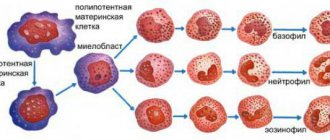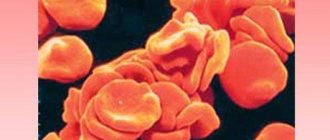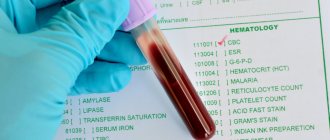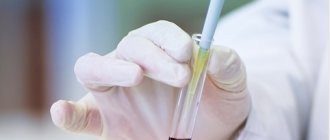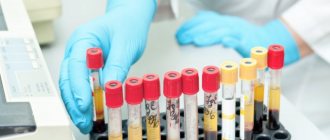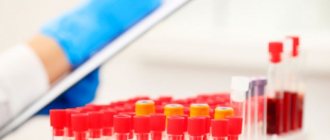Insulin is a hormone produced by the beta cells of the islets of Langerhans in the pancreas. The name insulin comes from the Latin insula - island. Effects of insulin
Although insulin causes many effects in various tissues of the human body, its main effect is to stimulate the movement of glucose from the blood into cells, which leads to a decrease in blood glucose concentrations.
Other effects of insulin are stimulating the synthesis of glycogen from glucose in the liver and muscles, increasing the creation of fats and proteins, and suppressing the activity of enzymes that break down fats and proteins. Thus, insulin has an anabolic effect because it enhances the formation of fats and proteins while slowing down their breakdown.
The main effect of insulin is to enhance the transport of glucose across the cell membrane into the cell. There are no other hormones that lower blood glucose levels in the human body. The main effects of insulin occur in muscle and adipose tissue, which is why these tissues are called insulin-dependent. Blood glucose levels decrease when exposed to insulin and increase when exposed to the so-called. hyperglycemic hormones (glucagon, growth hormone, glucocorticoids).
Additional effects of insulin are an increase in the intensity of glycogen formation, a decrease in the formation of glucose in the liver, and an increase in the absorption by cells of amino acids necessary for protein synthesis. At the same time, insulin reduces the destruction of proteins and fats. Thus, the overall effect of insulin is anabolic - aimed at the formation of fat and muscle tissue.
General information
In order for a person to lead an active lifestyle, and for his body to function correctly, without failures, energy must flow into the cells, tissues of organs and systems. Its main source is glucose in the blood. To break it down and convert it into energy, it is necessary to have a certain hormone produced by the pancreas - insulin.
As a result of the development of any diseases of this organ, the production of the hormone decreases. The breakdown of glucose slows down. This leads to energy deficiency, which negatively affects the functioning of all human organs. At the same time, as food continues to enter the body, blood sugar levels rise, sometimes significantly exceeding normal levels. It settles in blood vessels in the form of single crystals. A person develops a dangerous, intractable disease – diabetes mellitus.
There are two types of diabetes:
- T1DM – consists of pancreatic dysfunction, insulin stops being produced completely or partially; energy does not flow to the cells;
- T2DM – characterized by cell insensitivity to insulin; Despite the fact that the gland continues to produce the hormone in sufficient quantities, the cells that have lost sensitivity do not absorb energy, and the sugar level in the blood increases.
Depending on what type of disease a person suffers from, a specific treatment method is prescribed. With T2DM, in some cases, following a special diet may be sufficient. If this method turns out to be ineffective, then over time the gland begins to produce less hormone. In this case, as with type 1 diabetes, insulin preparations are prescribed, which prevent the development of complications, expressed in disturbances in the functioning of internal organs (heart, kidneys), blood vessels, and decreased vision.
Insulin synthesis disorders and type 2 diabetes
Sometimes the pancreas stops producing insulin in the required quantities. If this is observed regularly, the patient develops type 2 diabetes. This is a metabolic disorder that manifests itself with a number of symptoms:
- excessive feeling of thirst;
- frequent acts of urination;
- excessive feeling of hunger;
- vision problems (blurred);
- feeling of lack of strength;
- increased fatigue;
- numbness, tingling in the upper and lower extremities;
- long-lasting wounds.
Type 2 diabetes mellitus is a dangerous disease that leads to a number of complications, including death:
- strokes of various types;
- nephropathy;
- polyneuropathy;
- dementia;
- diabetic foot and others.
Insulin tablets
Despite this, many people with diabetes are afraid to start taking insulin. The main reason for this is the need for constant administration of the drug in the form of injections. The dream of many diabetics is insulin tablets. Despite the fact that you can sometimes find media reports that scientists from America and Australia were able to invent insulin tablets, this is most likely not true.
The dream of pills for type 1 diabetes is not yet possible. At the moment, this is the only method of treating T1DM that allows not only to improve the quality of life of a sick person, but also to significantly increase its duration. At the same time, it is not necessary to use a syringe to administer insulin, which is always difficult. Today, scientists, pharmacologists, and doctors suggest using such an invention as a syringe pen. The procedure with their help is simple, and the use of special needles for insulin syringe pens allows you to administer the drug absolutely painlessly.
Insulin index of certain foods
The insulin index is an innovation in the science of proper nutrition and a detailed table with its exact value for various foods is still in an “open” state, is incomplete and is constantly being updated with new data.
But for the most popular food products, all the necessary calculations have already been carried out and we have quite accurate information that can be used by diabetics and ordinary citizens who want to lose excess weight.
Insulin index of greens and vegetables
Potato insulin index
Insulin index of berries, fruits and fruits
Insulin index of dairy products
Insulin index of sweets and treats
Insulin index of cereals and grains
Insulin index of bread, pastries and confectionery products
Insulin index of other common foods
Knowing the insulin index of foods is not enough. For the best result, it is important to take into account the compatibility of products. A great option is to combine vegetables with proteins and fats (vegetable salad with olive oil and a piece of poultry). Starchy foods (porridge, beans, potatoes, white rice, beets) are good to eat with leafy vegetables and oils.
Avoid combining fast carbohydrates with starchy, protein foods (a sandwich or burger is one of the typical combinations). It is not the best option to mix protein foods (fish, meat, poultry) with starchy foods (that is, with traditional side dishes - white rice or mashed potatoes).
We recommend
“Buckwheat tea: beneficial properties, contraindications and reviews” Read more
Here are some more simple tips to consider when planning a diet for diabetics:
and people suffering from prediabetic conditions.
- For a very long time, the thesis has flourished in dietetics that such “healthy” foods with a low glycemic index, such as cottage cheese, are best consumed at night; this, in theory, should promote weight loss and active “nighttime” fat burning. But with the advent of new research on the insulin index, the outdated postulates of nutrition science must be adjusted.
It has now become clear that cottage cheese has a very high AI and is not suitable for consumption in the afternoon by people with diabetes and those with insulin resistance.
- Products with an insulin index above average go very poorly with fatty foods.
- When drinking alcohol with a “bad” AI, it is better to avoid high-fat snacks.
- The first half of the day is a great time to refuel with something tasty with a high insulin index. It is best to have dinner with fish, vegetables, seafood and other “goodies” with a low insulin and glycemic index, in order to eliminate the possibility of sharp evening insulin surges and protect the body from gaining excess weight.
Classification of insulin
But even if the patient decides to take insulin injections, he will not be able to purchase the drug at the pharmacy on his own. It must be selected by an endocrinologist, especially since there are a lot of types of insulin on the shelves of modern pharmacies and it is very difficult to understand their purpose without special knowledge.
All insulin preparations are classified into types according to several criteria. For example, depending on the “origin”, the following types of insulin are distinguished.
- Obtained from the pancreas of pigs or cattle. The first option is preferable, since it is closer to the human one. In the second case, an allergic reaction may occur.
- Synthesized artificially using human rDNA insulin.
- Genetically engineered, it is also obtained from pork insulin using modern innovative technologies, which makes it possible to obtain a drug almost identical to the human hormone.
The following classification method takes into account the speed of penetration of the drug into the blood and the duration of its action. On this basis, insulin is divided into the following categories:
- ultra-short;
- short;
- average;
- long.
The drugs of the last two categories are considered basic, basic. They are administered 1-2 times a day, which allows you to maintain blood sugar levels at a normal level for a long period of time. Ultra-short and short preparations are used before each meal, which helps prevent the increase in blood sugar levels caused by the intake of food into the body.
Ultra-short
When used to lower blood sugar levels, it must be remembered that the faster the effect of the drug occurs, the shorter the duration of its action. The fastest, ultra-short drugs begin to work 10 minutes after administration. These are very powerful, effective medications, the effect of which is as close as possible to the natural hormone and lasts for 3 hours. The injection is given immediately before or immediately after a meal.
Short
The effect of the drug begins after 30 minutes and lasts for 5-8 hours. Preliminary administration of the medicine allows it to begin working simultaneously with the intake of food into the body, and it is desirable that it contains predominantly slow carbohydrates. A long period of action leads to the fact that the hormone remains in the blood after all the food has been absorbed and the amount of glucose in the blood has decreased. To prevent this from leading to hypoglycemia, additional food intake (snack) is necessary.
Like other insulin preparations, short- and ultra-short-acting drugs are introduced into the body using disposable syringes or reusable insulin pens into the subcutaneous fatty tissue. This promotes a more uniform, slow penetration of the hormone into the blood. The rate of absorption depends on various factors, primarily:
- injection site, it can be the shoulder, thigh, but the drug begins to act most quickly when it is injected into the stomach;
- the dose of the administered medication, the larger it is, the more effective the effect will be;
- the thickness of the fat layer, the smaller it is, the faster the absorption will be.
The drug and its dose are selected by a specialist endocrinologist, taking into account the characteristics of the patient’s body, depending on the stage of development of the disease. But a person with diabetes can independently regulate the dose, depending on the number of “bread units” entering the body: 1 unit of short-acting insulin is administered per 1 unit of bread, so that no more than 1 unit per kilogram of body weight enters the body at a time.
To accurately determine the dose, doctors recommend that patients keep a “food diary”. It is necessary to record each meal, the sugar level measured after that, the dose and name of the administered drug, and the concentration of glucose in the blood after taking the drug. This “Diary” allows the treating endocrinologist to choose a more effective treatment method. In addition, in the event of an emergency (the development of ketoacidosis), an emergency doctor or an intensive care unit specialist called to the house will also be able to use the notes taken to determine which medicine should be used to provide emergency care. In this case, the injection is given intravenously.
Medium and long
These drugs are intended for basic, basic therapy. They must be used daily, regardless of the time and amount of food taken. Medium-duration medications require administration twice a day: 2/3 of the dose in the morning before breakfast and 1/3 of the dose before dinner. With medium-lasting insulin, the effect is achieved after 1-1.5 hours, and the duration is 20 hours. Long-acting (long-term) insulin can be used once a day. It starts working in 1-3 hours. The main advantage of its use: the absence of a peak of activity. The concentration of insulin in the blood remains at a constant level throughout the entire duration of action, that is, 24 hours.
Depending on the type of diabetes mellitus, the stage of development of the disease, and the characteristics of the body, the doctor will prescribe one of two insulin therapy technologies.
- Combined. It is also called traditional and is used to treat patients who cannot take care of themselves or control the dose of the administered drug: elderly people, patients with diabetes with mental disorders, and so on. It involves the simultaneous administration of two drugs using one medical syringe, one of which is basic (medium-acting or long-acting), and the second is a short-acting drug. Its main disadvantage is its low efficiency, which leads to earlier manifestation of various complications.
- Basis-bolus therapy. In this case, both short and long-acting (medium) insulin preparations are also used. But unlike the traditional method, this option does not involve “mixing” them. They are administered in different injections, which makes it possible to bring their effect closer to the physiological production of the hormone by the body itself. This method is considered the best and is used more often.
How to determine insulin levels
Insulin levels can be determined in a laboratory setting using a venous blood test. It is carried out for different purposes:
- detection of type 2 diabetes;
- identifying the need for artificial insulin intake;
- determining the causes of hypoglycemia (low blood glucose).
The analysis is carried out only as prescribed by a doctor. The main prerequisites are:
- sweating;
- blurred vision;
- cardiopalmus;
- frequent feeling of hunger;
- heart attacks;
- dizziness;
- to determine whether the insulinoma (pancreatic tumor) was successfully excised;
- for diagnosing relapses of insulinoma;
- to control the transplantation of Langerhans islet cells after the intervention.
Before conducting the study, certain preparation is required:
- do not eat food for at least 12 hours;
- do not take medications 24 hours in advance (check with your doctor);
- do not smoke at least 3 hours before the test.
Release form
Insulin preparations go on sale in the form of solutions or suspensions, packaged in glass hermetically sealed bottles (5-10 ml). The top of the cork is rolled with an aluminum cap. For use in conjunction with a syringe pen, medicines are packaged in special cartridges (cases, cartridges).
For use in medical institutions, the drug can be in the form of a soluble white powder. It contains at least 3.1% sulfur. To introduce it into the body, it is diluted with special water for injection with the addition of hydrochloric acid, glycerin, and a solution of phenol (tricresol).
The structure of insulin[edit | edit code]
A few years later, Abel obtained pure crystalline insulin, but the amino acid sequence of this hormone was deciphered by Sanger only in 1960. In 1963, artificial insulin was synthesized, and in 1972, Hodgkin and his colleagues established its spatial structure. Insulin was the first hormone to be determined using RIA (Yalow, 1978).
Beta cells of the pancreatic islets synthesize insulin from preproinsulin, a single-chain precursor protein consisting of 110 amino acid residues. After transfer through the membrane of the rough endoplasmic reticulum, the acidic N-terminal signal peptide of 24 amino acid residues is cleaved from preproinsulin, and proinsulin is formed (Fig. 61.1)
Figure 61.1. Human proinsulin and its conversion to insulin.
. At this stage, disulfide bonds are formed and the molecule acquires a tertiary structure. In the Golgi apparatus, proteases cleave off four main amino acid residues and a connecting link, the C-peptide, from human proinsulin. The result is two peptide chains (A and B), which together make up the insulin molecule. Each of the chains contains one disulfide bond, and they are connected to each other by two more. The A chain usually contains 21 amino acid residues, the B chain - 30; the molecular weight of insulin is 5734. The amino acid sequence of insulin is considered conservative, but during evolution it underwent significant changes that affected the biological activity and immunogenicity of this hormone (De Meyts, 1994). Most species have one insulin gene, which codes for one protein. The exception is rats and mice, which have two insulin genes. They produce two insulins, differing in two amino acid residues of the B-chain.
The crystal structure of insulin has now been studied with a resolution of 0.15 nm. Both chains of the hormone have a very ordered structure with several α-helical regions. Individually, insulin chains do not have biological activity. In solution, insulin can exist as a monomer, dimer or hexamer. The hexamer is formed with the participation of two Zn + ions; It is believed that it is in this form that insulin is stored in the secretory granules of β-cells. Apparently, Zn + plays a leading role in the formation of insulin crystals, and crystallization accelerates the process of converting proinsulin into insulin and facilitates storage of the hormone. Most insulin preparations contain a highly concentrated solution of hormone hexamers. After the insulin drug is absorbed and its concentration drops to physiological (nanomolar), the hormone breaks down into monomers, which have biological activity. Recently, insulin preparations containing hormone monomers have appeared.
Much of our knowledge about the relationship between the structure and activity of insulin was obtained from studying the insulins of various animal species, as well as through chemical modifications of the hormone molecule. Invariant amino acid residues (Gly\Glu\Gln5, Tyr1'*, Asn21 in the A-chain and Val12, Tyr16, Gly23, Phen24, Phen and Tyr26 in the B-chain) form a structure that interacts with the insulin receptor (Fig. 61.2). Some of these residues are also involved in insulin dimerization (de Meyts, 1994). Ley13 A-chain and Ley17 B-chain appear to form the second binding site (de Meyts, 1994). Insulin binds to the N-terminal and C-terminal regions of the α-subunit of the receptor. It is believed that the cysteine-rich fragment of the α-subunit of the receptor is also involved in binding. Typically, insulin's affinity for its receptor correlates with the hormone's ability to influence glucose metabolism. Bovine and porcine insulins have biological activity equal to that of human insulin, guinea pig insulin is much less active, and some avian insulins are more active than human insulins.
Insulin is part of a family of peptides called insulin-like growth factors - IGFs. Two of them (IGF-I and IGF-II) have a molecular weight of about 7500 and are structurally similar to proinsulin (Cohick and Clemmons, 1993). The IGF molecule contains regions identical to the C-peptide of proinsulin. Unlike insulin, IGFs are produced by many tissues and are primarily involved in the regulation of growth rather than metabolism. It is believed that these peptides, especially IGF-1, mediate the action of GH (they were previously even called somatomedins). It is possible that relaxin, a hormone secreted by the corpus luteum during pregnancy, is distantly related to IGF.
The insulin and IGF-I receptors are also similar in structure (Duronio and Jacobs, 1988). Therefore, insulin, although with low affinity, binds to the IGF-I receptor, and IGF-1 binds to the insulin receptor. The stimulatory effect of insulin on cell proliferation is believed to be mediated, at least in part, by the IGF-I receptor. The metabolic and mitogenic activities of insulin analogues do not always correlate. For example, the metabolic activity of proinsulin is 50 times less than that of insulin, and the mitogenic activity is only 2 times less (King and Kahn, 1981). This must be taken into account when choosing an insulin drug, since the stimulating effect on cell proliferation increases the risk of atherosclerosis.
pharmachologic effect
Insulin drugs affect all tissues and internal organs of the human body. But its “work” is most pronounced in its effect on muscle and fat tissue, the liver, metabolic processes occurring in the body, and digestion. Among the main functions of these drugs:
- regulation of carbohydrate metabolism due to stimulation of glucose penetration through the cell membrane, which promotes its conversion into glycogen and further utilization;
- increased glycogen content in muscle tissue;
- stimulation of the formation of peptides, glucosyltransferase, hexokinase enzyme, pyruvate dehydrogenase multienzyme complex;
- suppression of fat breakdown (lipolysis), which leads to a reduction in the amount of free fatty acids and reduces their entry into the systemic circulation;
- reduces the formation of glucose from fatty acids and amino acids, prevents the breakdown of glycogen (glycogenolysis);
- prevents the synthesis of ketone (acetate) bodies;
- slows down the process of converting amino acids into oxocarboxylic acids and so on.
The effectiveness of the drug depends on the characteristics of the body, muscle activity, blood flow speed at the injection site, the administered drug and its dose. The effect of a substance can be different not only in different people, but also in the same person, depending on his condition.
The concept of glycemic index and glycemic load
Before introducing the concept of insulin index, it is worth considering the more well-known and more often used concept of “glycemic index”.
The glycemic index (GI) characterizes the degree of absorption of complex carbohydrates from food and the subsequent level of blood saturation with glucose.
The GI value depends on the ability of complex carbohydrates to be broken down under the influence of digestive enzymes and on a number of “external” factors associated with cultivation, production technologies, storage conditions and culinary processing of food.
The GI value was determined experimentally - after taking a certain product, for 2 hours, every 15 minutes, a blood sugar test was carried out. Naturally, for such a comparison of the behavior of dietary carbohydrates and compiling a table, we took ordinary glucose as the starting point - absorption of 100 g = 100% or 1 g of glucose equals 1 conventional GI unit.
After a snack, the amount of sugar in your blood rises within 30 minutes. If you eat fast carbohydrates, then this time is reduced. The pancreas strives to reduce glucose levels, produces insulin and directs it to the body's needs: either for energy or for reserves. It depends on what kind of carbohydrates and how much you ate - fast or slow. The fast ones cause a sharp jump and create a surplus, while the slow ones feed the body gradually. Therefore, when reducing the total caloric content of the diet, foods with a low GI are preferable - they maintain a feeling of fullness longer at the same calorie content.
Pros of low GI foods
:
- Gradually nourishes the body and prolongs the feeling of fullness.
- Does not cause a sharp increase in blood glucose.
- They don’t have time to get into the adipose tissue, because slowly spent on the needs of the body.
Disadvantages of Low GI Foods
:
- They take a long time to replenish glycogen stores, so they are not suitable for quickly obtaining energy.
- Low energy density. For example, it is impossible to get a large amount of carbohydrates from buckwheat, because such volumes are simply impossible to eat. Therefore, to quickly replenish energy, you need fast carbohydrates.
- Taste. In general, low GI foods are not as tasty as high GI foods.
Simultaneously with GI, the concept of Glycemic Load (GL) was introduced, because the metabolism of carbohydrate metabolism is affected not only by the structure of carbohydrates, but also by their direct quantity.
GN allows you to characterize the load on the pancreas experienced when producing the required amount of insulin in response to a specific food product. For example, the load from 50 g of potato carbohydrates is 3 times higher than from the same 50 g of vermicelli carbohydrates. Some considered this to be a low workload.
Injection technique
Insulin can be administered independently, without assistance. To do this, you can use an insulin syringe or a special syringe pen. The latter method is more preferable, since it allows you to more accurately measure the required amount of substance. Another advantage is that the injection can be given directly through clothing, which is especially convenient for patients with diabetes who lead an active lifestyle: studying at a university, working in offices.
It is imperative to comply with all antiseptic requirements: wash your hands with soap, use only disposable syringes, treat the injection site with alcohol or alcohol-based antiseptic wipes. It should be remembered that alcohol destroys insulin, therefore, after treating the injection site, you must wait until the alcohol-containing liquid used for disinfection has completely dried, and only then inject. Do not inject the drug into the same place multiple times. Each time you need to retreat from the previous puncture by 2-3 centimeters. Changing the area of drug administration is done to prevent lipodystrophy.
Another method of administering insulin is called an insulin pump, which provides a continuous supply of the hormone. The system is a kind of syringe dispenser, consisting of the pump itself, a small computer designed to calculate the dose and control the drug administration regimen, a reservoir with the drug and a thin needle (cannula) for administering the drug.
This method of treatment is becoming increasingly widespread, since it allows one to take into account the amount of residual insulin in the blood and the amount of food entering the body. For administration using an insulin pump, ultra-short and short-acting drugs are used, but the number of skin punctures is minimized.
When using an insulin pump (doser), patients with diabetes have a more stable course of the disease, the quality of life increases, and the likelihood of complications decreases. At the same time, skeptics also note the negative aspects of using this method. First of all, this is an inconvenience, especially for those who want to lead an active lifestyle. In addition, a patient with diabetes is completely dependent on technology, because the process is completely automated. A malfunction of the program, failure of the device, or sudden loss of battery charge can lead to ketoacidosis. Another negative factor that is significant for many Russians is the high cost of the device.
What do the analysis results mean?
During the study, blood is drawn from a vein, after which the concentration of the hormone is determined using a chemical analysis. A value in the range from 2.6 to 24.9 µU/ml of blood is taken as normal.
If the norm is exceeded, the patient is sent for additional diagnostics to determine possible causes. The most common ones are:
- acromegaly;
- insulinoma;
- pancreas cancer;
- chronic pancreatitis;
- Itsenko-Cushing syndrome;
- obesity of varying degrees;
- intolerance to simple carbohydrates (glucose, galactose, fructose).
Insulin in bodybuilding
Some athletes and coaches believe that insulin drugs, especially short-acting ones, in combination with anabolic steroids and androgenic substances used in sports, will allow them to achieve better results. Indeed, regardless of whether the drug is administered to a sick or healthy person, its mechanism of action will be the same. In particular, the permeability of cell membranes in muscle tissue will increase. As a result, the process of penetration of steroids into cells will accelerate. Even if there is a small amount, the consequences can be more significant than without the use of insulin.
But athletes, like patients with diabetes, should carefully monitor compliance with the dosage and not forget about other, no less important rules:
- control the amount of nutrients entering the body, an excess of which will lead to their deposition as fat;
- reduce the amount of simple carbohydrates consumed;
- control not only the weight, but also the volume of the biceps, shins, and thighs.
The appearance of fatty deposits and folds indicates an incorrect calculation, the need to reduce the dose or completely stop introducing insulin drugs into the body.
Preparing for analysis
Reliable research values are achieved by following the list of recommendations:
- A prerequisite for taking blood is to donate blood on an empty stomach. The duration of fasting should be at least 8-14 hours. Drinking water without gas is allowed.
- Avoid drinking alcohol and smoking before taking blood.
- Complex sets of physical exercises and strenuous training should be excluded.
- Taking medications in preparation for diagnostic procedures should be agreed with the attending physician. Provided that they cannot be canceled, you need to warn the biochemical laboratory specialists about this.
- It is not recommended to carry out blood sampling procedures immediately after physiotherapeutic procedures, ultrasound, radiographic and other examinations.
- You should not combine a prostate biopsy and sigmoidoscopy on the same day with an insulin test.
Tests can be taken at municipal medical institutions or commercial clinics. The latter option is more often considered when the patient does not have free time or in emergency cases. The price for the study depends on the region and varies from 680 rubles and above. It should be noted that this amount does not include blood sampling, the cost of which is 199 rubles.
Treatment and prognosis
Treatment of insulinoma in most cases is surgical: enucleation of the tumor, distal resection of the pancreas in appropriate localization. Conservative therapy is carried out in the case of an unresectable tumor and its metastases, as well as if the patient refuses surgical treatment. The five-year survival rate among radically operated patients is 90%, and if metastases are detected, it is 20% [8].
Sources
- Clinical endocrinology: manual (3rd ed.)/Ed. N. T. Starkova. - St. Petersburg: Peter, 2002. - 576 p.
- MedUniver
- MedUniver
- Endocrinology. Volume 2. Diseases of the pancreas, parathyroid and gonads. Ed. S. B. Shustova. - St. Petersburg: SpetsLit, 2011. - 432 p.
- Balabolkin M.I., Klebanova E.M., Kreminskaya V.M. Differential diagnosis and treatment of endocrine diseases (guidelines). M.: “Medicine”, 2002. - 751c.
- Dizon AM et al. Neuroglycopenic and other symptoms in patients with insulinoma // Am. J. Med. 1999, p. 307.
- Okorokov A. N. Diagnosis of diseases of internal organs. Volume 2. - M. Med. lit., 2008–576 p.
- Kalinin A.P. et al. Insulinoma. Medical newspaper, 2007, No. 45, p. 8–9

